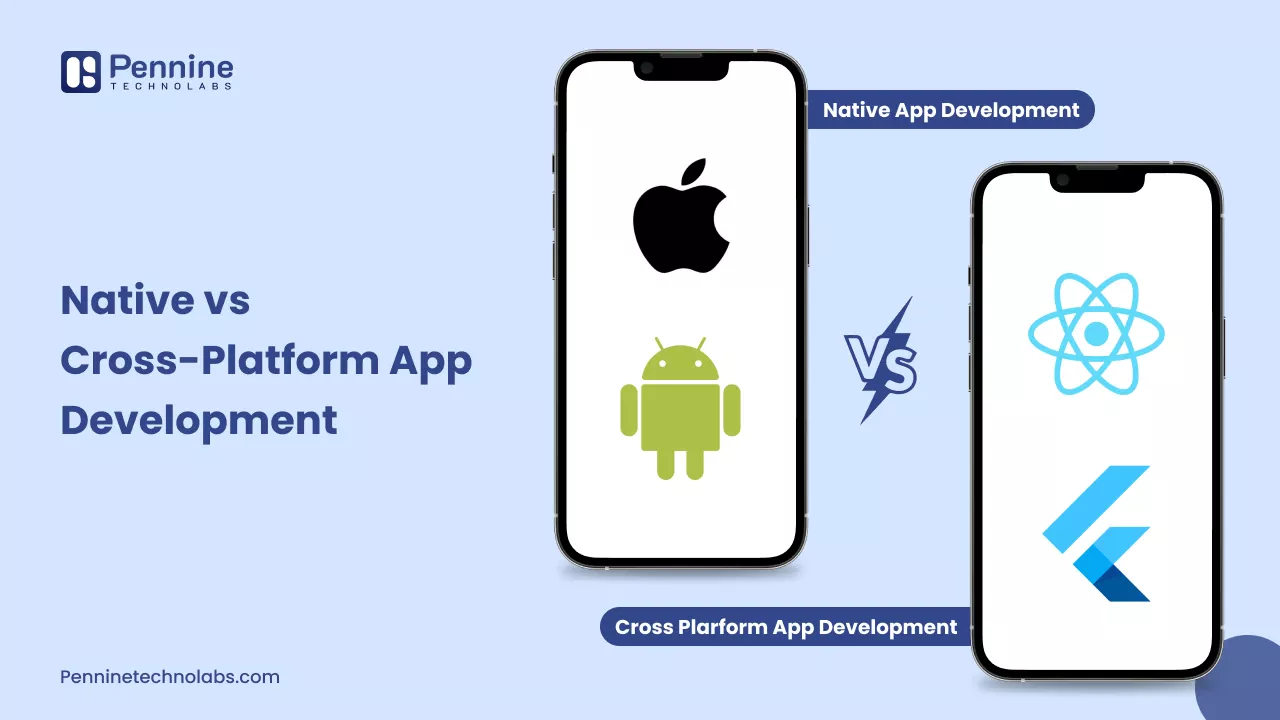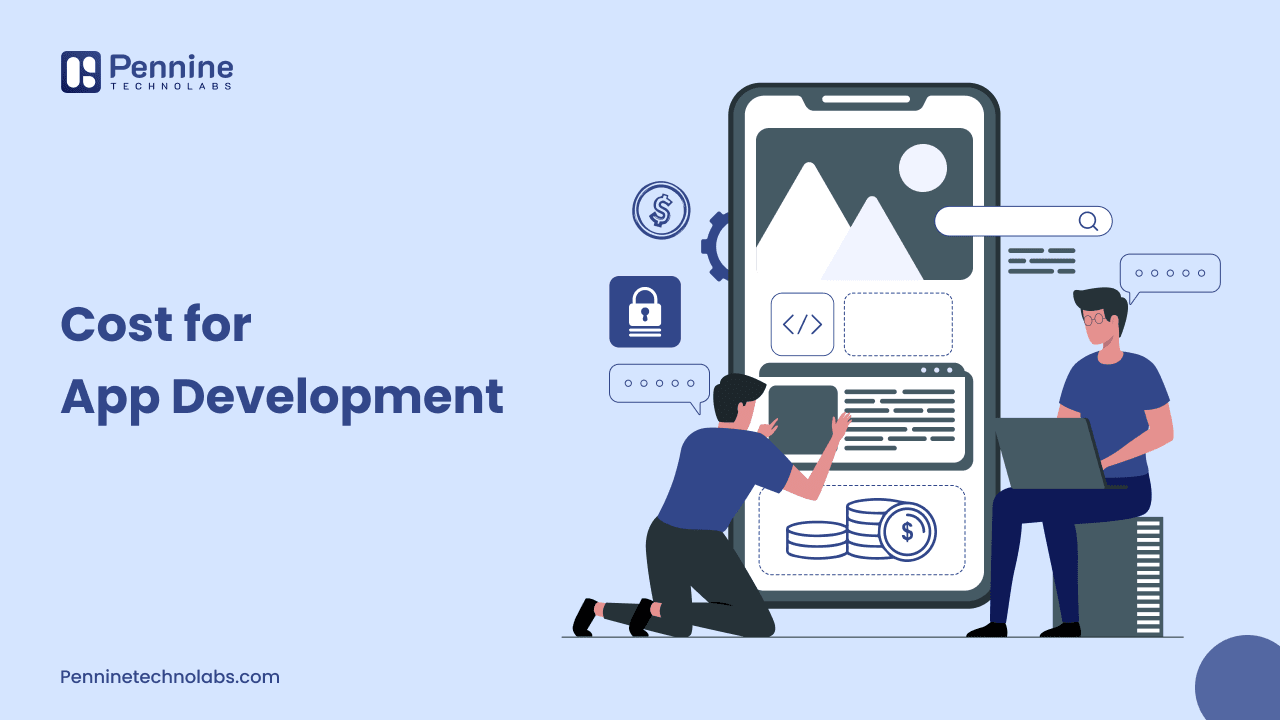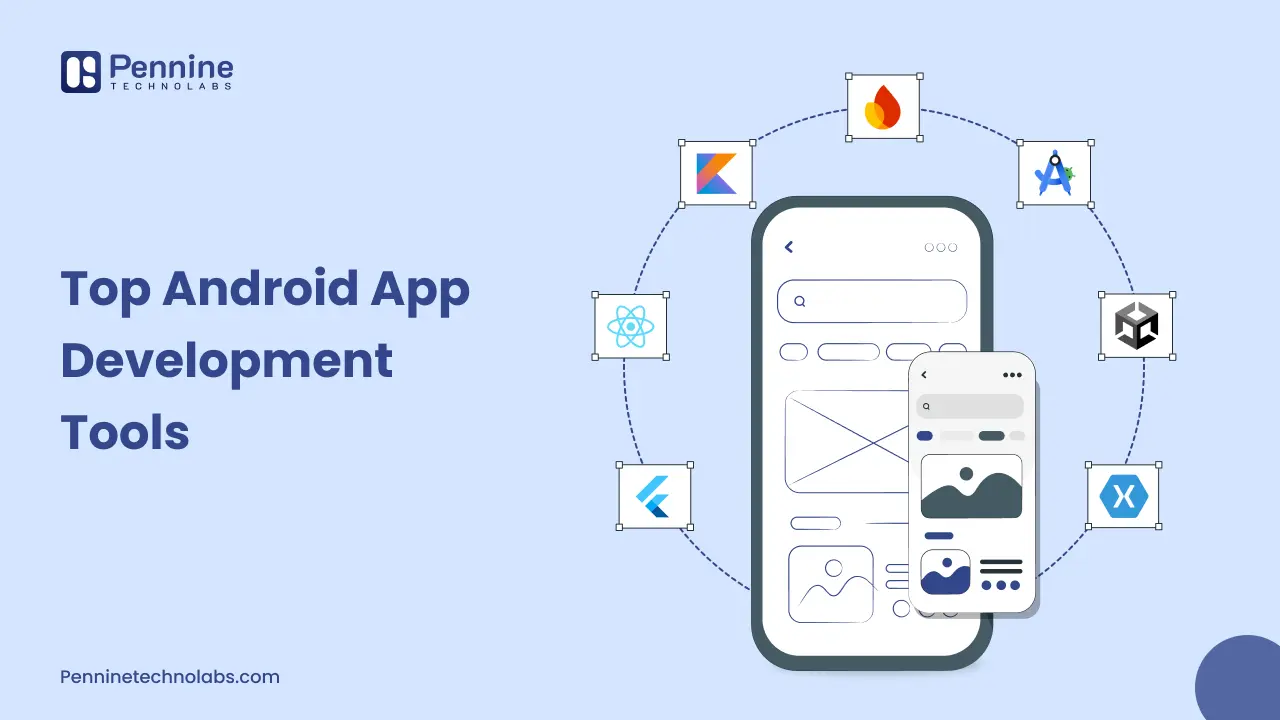Quick Summary: The selection between native and cross-platform app development depends on your project goals, budget and timeline. Native apps provide unmatched performance, deeper integration with device features and a better user experience. Cross-platform apps offer rapid growth, low cost and wide access with a single codebase. This blog considers professionals, opposition, equipment and factors when making the right choice for your app.
Mobile apps are now a primary channel for businesses to connect with customers. The performance of your app and ease of use are essential for its success, whether it is an ecommerce platform, a healthcare solution, a trip booking app, or an entertainment experience.
Choosing between native app development and cross-platform app development is one of the most important things you need to do before starting construction. Each has its advantages and cons. What you want to achieve, how much money to invest, who you want to reach, and your long-term vision will all affect the people you choose.
We help organizations determine their needs and select an optimal technical stack at Pennine Technolabs. Let’s look at the differences, benefits and negatives so that you can choose the best option for your business goals.
What is Native App Development?
Native development means creating an app for an operating system using its official programming languages and equipment. IOS apps are usually made with Swift or Objective-C using Xcode, while Android apps use Java or Kotlin with Android Studio.
Because these apps are adapted to the same platform, they provide extraordinary performance, intensive integration with device features and an improved user experience.
Native mobile app development is compiled in the machine code for their specific operating systems, making them very fast, stable and reliable. Native apps handle real-time interaction without heavy processing tasks, advanced animations, and performance drops, ensuring a smooth user experience for an app such as gaming or AR.
Pros of Native App Development
Access to Features
Since native development uses official features, mobile app developers can tap each device-specific function, such as advanced camera control, biometric authentication, NFC payment, GPS tracking and push notifications. Additional features ensure maximum hardware integration without relying on external libraries.
Platform-specific UI/UX
A proper platform guideline by Apple or Google content design provides a unique interface that feels perfectly natural to the user. The platform-specific UI/UX enhances user experience and overall satisfaction.
Better Security
The OS already adapts the native apps, and hence they offer encryption, secure data storage and advanced authentication. With regular updates, this becomes an ideal choice for industries like banking, healthcare or eCommerce where data is protected.
Offline Capability
The native application stores and processes data locally with high efficiency, keeping core features functional without a stable internet. It is helpful for travel applications, field tools or productivity platforms used in remote locations.
Scalability
Since they are specifically designed for a platform, it is easy to score native apps with advanced features and large user bases. This makes them a long-term solution for businesses that plan significant growth.
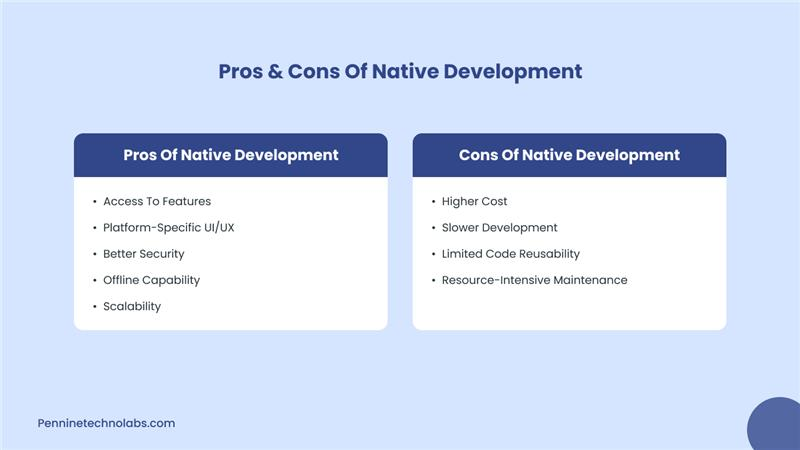
Cons of Native Development
Higher Cost
Separate apps for iOS and Android require dedicated design, development, and QA resources. This duplication increases prices, making local development investment more.
Slower Development
Two codebases mean longer build and replace times. Releasing new features or fixes takes more time compared to a single cross-platform project.
Limited Code Reusability
Code written for one platform cannot be reused for another, requiring a double attempt in development and maintenance.
Resource-Intensive Maintenance
Ongoing support, bug fixes, and overall performance testing need to be accomplished separately for each version of the app, including operational overhead.
Popular Native App Development Tools
- Xcode for iOS development
- Android Studio for Android development
- Swift and Objective-C for iOS programming
- Java and Kotlin for Android programming
What is a Cross-Platform Mobile Application?
Cross-platform development allows you to create a single codebase that runs on several platforms, including iOS and Android. Flutter, React Native and Xamarin frameworks can offer a good quality application rapidly and better pricing than creating two separate versions.
This approach is ideal for businesses achieving wide access without the complexity of managing two separate projects.
Pros of Cross-Platform Mobile App
Faster Development
A shared codebase reduces duplication, allowing developers to launch on several platforms simultaneously. It shortens the deadline and helps businesses to test the concepts quickly in the market.
Effective cost
Cross-platform cost makes it an attractive option for startups and companies that aim to maximise the price from a limited budget.
Better Reach
Launching the application on iOS and Android simultaneously ensures that you capture a broader audience from the start, enhancing early adoption.
Easier Maintenance
A single codebase means that bug fixes and updates are applied once and are deployed everywhere, which ensures stability and saves time.
Single development team
You only require efficient developers in a framework such as Flutter or React Native, removing separate platform-specific teams.
Consistent Branding
Shared UI components and styles make it easier to maintain visual stability in platforms, strengthening the brand identity.
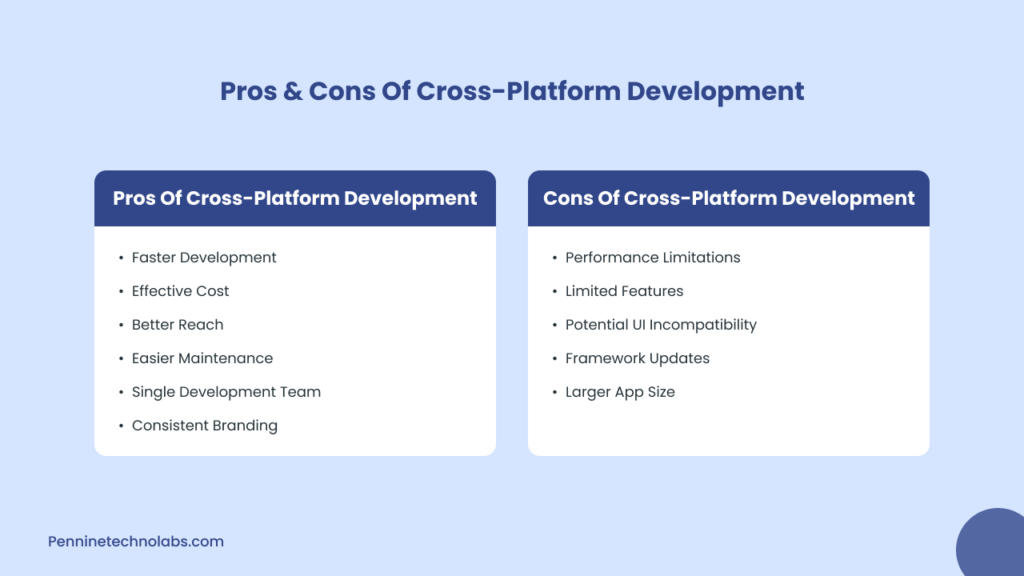
Cons of Cross-Platform Applications
Performance Limitations
Modern frameworks are efficient, and apps cannot run smoothly in their original forms, which require high-demand processing, such as complex 3D games or heavy multimedia.
Limited Features
Some advanced devices may not be fully supported, requiring native code integration, which may add complexity.
Potential UI incompatibility
UI components can differ slightly between platforms, leading to microscopic visual or functional differences that affect design accuracy.
Framework Updates
If the framework does not immediately support the new OS features, your app may face a delay in adopting them.
Larger App Size
The cross-platform app often consists of additional libraries, resulting in large installation files, which can affect users with slow internet or limited storage areas.
Popular Cross-Platform Tools
- Flutter (Google)
- React Native (Meta)
- Xamarin (Microsoft)
- Ionic
How to choose between Native vs Cross Platform Mobile App Development
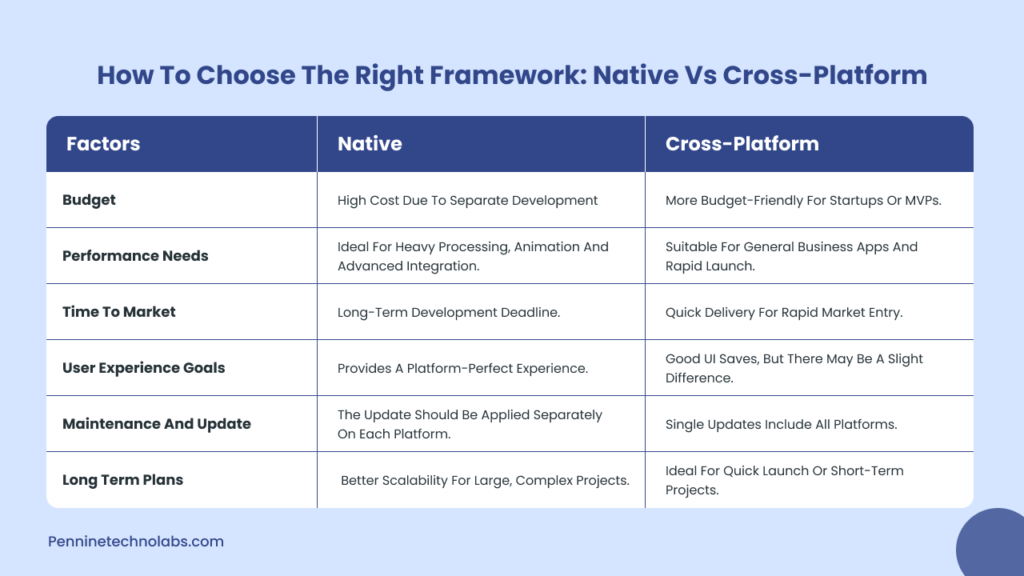
While deciding between native and cross-platform, consider these factors:
Budget
Native: High cost due to separate development.
Cross-platform: More budget-friendly for startups or MVPs.
Performance Needs
Native: Ideal for heavy processing, animation and advanced integration.
Cross-platform: Suitable for general business apps and rapid launch.
Time to Market
Natives: Long-term development deadline.
Cross-platform: Quick Delivery for rapid market entry.
User Experience Goals
Natives: Provides a platform-perfect experience.
Cross-platform: Good UI saves, but there may be a slight difference.
Maintenance and update
Native: The update should be applied separately on each platform.
Cross-platform: single updates include all platforms.
Long Term Plans
Native: Better scalability for large, complex projects.
Cross-platform: ideal for quick launch or short-term projects.
In Pennine Technolabs, we evaluate your requirements, timelines and budgets before recommending the best approach to the success of your app.
Native vs Cross Platform App Development Cost Comparison
| Cost Factor | Native App Development | Cross Platform App Development |
|---|---|---|
| Initial Development Cost | Higher due to separate iOS and Android apps | Lower because a single codebase is used |
| Design Cost | Separate UI design for each platform | Shared UI with minor platform adjustments |
| Development Time Cost | More development hours required | Fewer hours and faster delivery |
| Maintenance Cost | Higher ongoing maintenance for each platform | Lower maintenance with one codebase |
| Team Size | Larger team often needed | Smaller team can manage development |
| Long Term Cost | Higher but offers better performance at scale | Cost effective for startups and MVPs |
| Best Budget Fit | Enterprises and performance focused apps | Startups and budget conscious projects |
Hire Mobile App Developers
A successful mobile application begins with hiring dedicated mobile developers. We have highly qualified mobile app developers at Pennine Technolabs who have experience in native iOS and Android development and cross-platform development, such as Flutter and React Native. Our developers are performance-oriented, easy to use and scalable in the long term to provide your app with a smooth user experience.
We collaborate intimately with companies on their objectives and suggest the most appropriate development strategy according to budget constraints, schedule and feature specifications. Need a startup MVP, a consumer application or a highly sophisticated enterprise app? Our team has a structured development process to deliver reliable and secure mobile applications.
Hire Native app developers at Pennine Technolabs. With open communication, a flexible engagement model and proven technical expertise, we assist you in developing mobile applications that expand as your business expands, since your launch to support.
Final Thoughts
There is no one-sided solution in the Native Vs Cross-Platform App Development debate. Native offers unmatched performance, deep integration and scalability, while the cross-platform provides faster development, lower cost and broader reach..
Making the correct choice quickly, you save users time, resources, and potential rebirth, ensuring they get a high-quality experience. For specialist guidance and end-to-end development, Pennine Technolabs can help you design, build and scale an app that drives the results for your business.
FAQs on Native and Cross Platform Apps
Which is faster to develop: native or cross-platform?
Cross-platform development is usually faster because a single codebase works on several platforms, which reduces the requirement for different teams.
Are native apps always better in performance?
Yes, Native apps usually perform better, especially in functions with heavy processing, real-time updates, or advanced animation.
Can a Cross-Platform App access all device facilities?
Not always. While most framework provides access to general features, some advanced hardware capabilities may require indigenous code integration.
Which option is more cost-effective?
Cross-platform is more cost-effective in the short term since it requires the creation and maintenance of a codebase. Native development often costs more due to separate builds.
What approach should the startups choose?
The need for a startup and quick market entry with a limited budget often prefers a cross-platform approach. However, if performance and user experience are top priorities, Native development is a better option.
